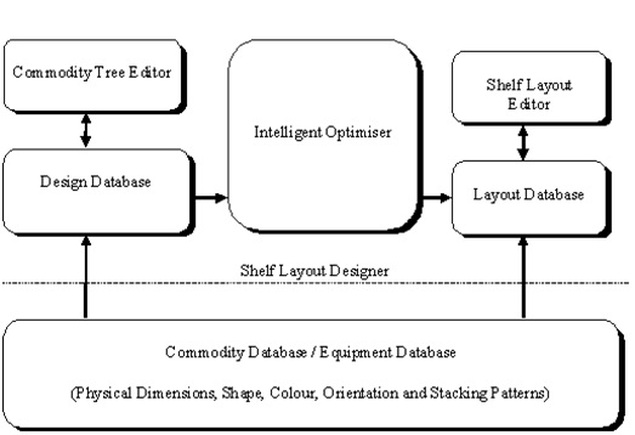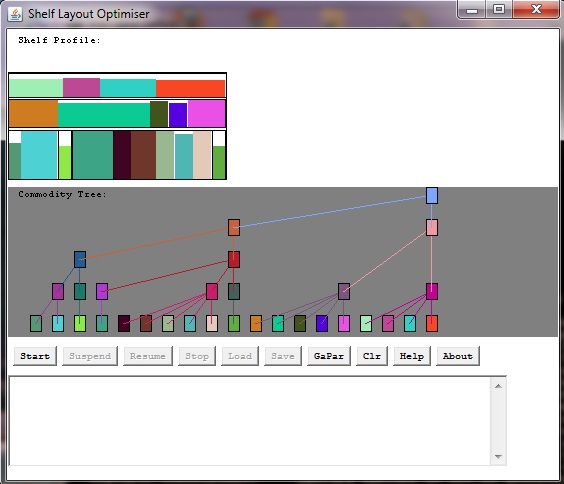Shelf Space Optimisation
Objectives
To generate a good shelf layout satisfying given aesthetic and physical constraints, the Shelf Layout Designer achieves this by:
Genetic Algorithm, integrated with database for shelf and commodity dimensions, and sales forecast for each department and store automatically generates the shelf layout.
To generate a good shelf layout satisfying given aesthetic and physical constraints, the Shelf Layout Designer achieves this by:
- Allocating space for commodities in proportion to their sale figures,
- Utilising physical shelf space efficiently, and
- Presenting an aesthetic layout for the customers.
- Commodities belonging to the same category form rectangular blocks,
- Subcategories also form smaller rectangular blocks within larger blocks.
- Commodity blocks may be required to be in certain locations on the layout,
- Commodities may be required to be placed in a number of orientation and stacking patterns, and
- Bulky commodities may be required to be on lower shelves
- Cheaper to the left
- Commodity Tree (defines the rectangular block structure),
- Commodity details (dimensions, sales figures),
- Shelf equipment details (dimensions),
- Display rules and constraints weighted by the user.
Genetic Algorithm, integrated with database for shelf and commodity dimensions, and sales forecast for each department and store automatically generates the shelf layout.
Shelf Layout Designer
(an `Intelligent’ system for designing/generating retail shelf layouts)
1. Introduction
The Shelf Layout Designer meets the following objectives:
2. Shelf Layout Designer
We developed a system which takes a number of inputs, and automatically generates near optimum layouts within a reasonable computational time. The inputs are typically:
3. System Modules
The system (Figure 1) contains the following modules:
(an `Intelligent’ system for designing/generating retail shelf layouts)
1. Introduction
The Shelf Layout Designer meets the following objectives:
- Allocates space for commodities in proportion to their sale figures,
- Utilises shelf space efficiently, and
- Presents an aesthetic layout for the customers.
- Commodities belonging to the same category form rectangular blocks,
- Subcategories also form smaller rectangular blocks within larger blocks,
- Commodity blocks may be required to be in certain locations on the layout,
- Commodities may be placed in a number of orientation and stacking patterns, and
- Bulky commodities are placed to lower shelves.
2. Shelf Layout Designer
We developed a system which takes a number of inputs, and automatically generates near optimum layouts within a reasonable computational time. The inputs are typically:
- Commodity details (dimensions, sales figures etc.),
- Shelf equipment details (dimensions),
- Display rules and constraints, and
- Layout design (based on commodity hierarchy).
3. System Modules
The system (Figure 1) contains the following modules:
- Intelligent Optimiser
- Commodity Tree Editor (GUI)
- Shelf Layout Editor (GUI)
- Design Database
- Layout Database

Figure 1. System Diagram
Intelligent Optimiser
The intelligent engine of the system is a hybrid of Genetic Algorithms and Rule Based Systems. It tries out thousands of layouts and by applying the principles of evolution, generates an optimum layout which satisfies all requirements. When there is not sufficient shelf space, it places a proportion of the required amount of units and suggests storing the rest in the warehouse. It uses intelligent rules in decision making to select which commodities should be placed in the warehouse and replenished during the day.
Commodity Tree Editor
This module enables business users to maintain and update commodity trees as inputs for the shelf layout designer. A simple Internet Browser based GUI allows users to add/delete or move nodes of a tree.
Shelf Layout Editor
This module enables business users to monitor, modify and when necessary to override system generated layouts. Again using the Internet Browser based GUI business users can enlarge the facing of a commodity on the layout, delete an unavailable product or insert a new product.
Design Database
A flat-file based module to keep a number of layout designs as outlines of layouts. Users can select, edit designs and prepare as inputs for the Intelligent Optimiser.
Layout Database
A flat-file based module stores all the layout descriptions. These layouts are generated by the optimiser, and can be edited using the Shelf Layout Editor.
4. System Specification
The Layout Designer software is platform-independent as it has been developed in Java. It runs on any hardware platform with an Internet Browser (Figure 2). This allows remote or local access to shelf layouts for viewing, editing or optimising, through the internet or intranet. Ideally the Design and Layout databases are set up to allow access from Internet Browsers, but this is not a requirement.
For the system to be implemented:
5. Performance
As the system uses a computationally intensive algorithm it requires a relatively high performance computer, recent tests show it is able to generate a good layout in a matter of minutes.
Again as a nature of the algorithm used, the system can not guarantee the optimum layout at each run, but the system always finds one of the best solutions available.
6. Potential Benefits to Business
Such a system will bring the following benefits:
The intelligent engine of the system is a hybrid of Genetic Algorithms and Rule Based Systems. It tries out thousands of layouts and by applying the principles of evolution, generates an optimum layout which satisfies all requirements. When there is not sufficient shelf space, it places a proportion of the required amount of units and suggests storing the rest in the warehouse. It uses intelligent rules in decision making to select which commodities should be placed in the warehouse and replenished during the day.
Commodity Tree Editor
This module enables business users to maintain and update commodity trees as inputs for the shelf layout designer. A simple Internet Browser based GUI allows users to add/delete or move nodes of a tree.
Shelf Layout Editor
This module enables business users to monitor, modify and when necessary to override system generated layouts. Again using the Internet Browser based GUI business users can enlarge the facing of a commodity on the layout, delete an unavailable product or insert a new product.
Design Database
A flat-file based module to keep a number of layout designs as outlines of layouts. Users can select, edit designs and prepare as inputs for the Intelligent Optimiser.
Layout Database
A flat-file based module stores all the layout descriptions. These layouts are generated by the optimiser, and can be edited using the Shelf Layout Editor.
4. System Specification
The Layout Designer software is platform-independent as it has been developed in Java. It runs on any hardware platform with an Internet Browser (Figure 2). This allows remote or local access to shelf layouts for viewing, editing or optimising, through the internet or intranet. Ideally the Design and Layout databases are set up to allow access from Internet Browsers, but this is not a requirement.
For the system to be implemented:
- Commodity Database is maintained and updated,
- Display rules and constraints are defined,
- Design Database is maintained and updated by the business user.
5. Performance
As the system uses a computationally intensive algorithm it requires a relatively high performance computer, recent tests show it is able to generate a good layout in a matter of minutes.
Again as a nature of the algorithm used, the system can not guarantee the optimum layout at each run, but the system always finds one of the best solutions available.
6. Potential Benefits to Business
Such a system will bring the following benefits:
- Reduces labour costs of shelf replenishment and within day replenishments,
- Provides consistent shelf layouts across a chain of outlets,
- Prevents unavailability / over-dressing,
- Increases the range available, through efficient use of shelf space,
- Provides the opportunity for corporate level monitoring of shelf layouts,
- Povides valuable information for data mining.
